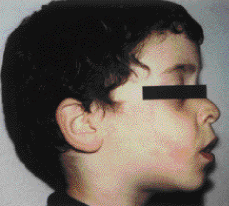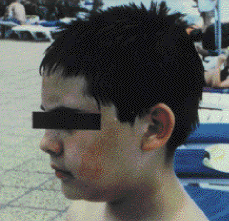INTRODUCTION
In the habitual clinical practice, a great number of adverse reactions to foods may be misinterpreted as allergic reactions. This can lead to the introduction of inadequate elimination diets in children.
CLINICAL CASES
Case 1
A 4 year-old boy was referred when he was 2 years-old, by presenting lineal erythema in the right cheeck after the ingesta of several foods such as corn flakes, chewing gums of acid flavors (strawberry, lemon) and nuts among others. The erythema appeared immediatly on mastication and disappeared in fifteen minutes without treatment. In his personal history he was diagnosed of Syndrome of Klipel-Trenaunay at the age of two years, and referred the use of forceps in the delivery. He also has a history of wheezing with colds.
Skin prick test to foods as corn, nuts, lemon and strawberry and a large battery with common inhalants (dust mites, molds, pollens and animal dander) were all negative. Open challenge test with corn flakes was positive. Figure 1.
Figura 1.--Lineal erythema in the rigth cheeck after open challenge test with corn flakes.
Case 2
A 10 years-old boy was referred by presenting facial lineal erythema after eating several fruits such as apple, orange, banana and lemon and others foods such bread and candies. Among his antecedents, referred the use of forceps in the delivery. Skin prick test to lemon, pear, banana, apple and orange were all negative. Open challenge test with apple reproduced the symptons. Figure 2.
Figura 2.--Facial lineal erythema after eating and apple.
DISCUSSION
The two studies clinical cases correspond to the Syndrome auriculotemporal, also known as "gustatory flushing", described for the first time by Frey in 1923 (1). It consists of an erythema appearance following the itinerary of the auriculotemporal nerve on mastication of diverse foods in absence of other symptons or signs. In adults all the causes are almost focused in the damage on the parotid gland either because of traumatisms, surgery or infections.
The auriculotemporal syndrome is uncommon in children (2). It has been related in some cases to the use of forceps in the delivery. In our two cases, both children had a traumatic delivery with the use of forceps.
This syndrome it has also been described in some children with epilepsy in the first years of their childhood, as well as in diverse diseases of the central nervous system (3). One of our patients is diagnosed of syndrome of Klipel-Trenaunay, this syndrome is made up by the following triad: café aut laits spots, hypertrophy of bones and soft fabrics as well as varicositys at different levels, including the central nervous system. As the pathogenia, the damage of the auriculotemporal nerve, gives place to an aberrant regeneration of the parasymphatic nervous fibers that occupy the place of the sympathetic fibers in their union to the sanguine vessels; then with the mastication of diverse foods, the aberrant fibers are stimulated, taking place a pathological vasodilatation instead the physiological salivate secretion (3).
At present there are several children with this syndrome. Kozma (4) describes a boy with syndrome auriculotemporal after eating cereals, this patient had had forceps in his delivery. Sampson (2) describes a boy with this syndrome after eating smoked food, tomato and several species with negative allergologic study. Beck (3) describes four children, between 6 months-old and 4 years-old with this syndrome after eating fruits and some sauces; three of them had had epilepsy and one of them forceps in his delivery.
In children the evolution is usually benign and in general they don't need treatment. In adults in same cases, the surgical resection of the nerve auriculotemporal with recurrence of the symptons several months later in a high percentage has been carried out.
The knowledge of this syndrome will avoid to start several studies in children that won't help in the diagnosis or they will mean the imposition of wrong diets of elimination.








